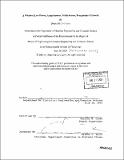A wireless, low power, asynchronous, multi-sensor, temperature network
Author(s)
Levy, Daniel M. G. H. (Daniel Matthew Guy Ho), 1979-
DownloadFull printable version (4.889Mb)
Other Contributors
Massachusetts Institute of Technology. Dept. of Electrical Engineering and Computer Science.
Advisor
Chathan M. Cooke.
Terms of use
Metadata
Show full item recordAbstract
Wireless communication is not new. Radio and television broadcasting, as well as air traffic control have used wireless signals in their products for decades. The transmitters for these applications require large antennas and a lot of power to drive the signal to many receivers, certainly too much for any kind of battery to provide. However, a lot of new products today are moving toward wireless data transfer, and the majority of these require power levels low enough that they can run off of a battery. Examples include cellular phones, personal digital assistants, and ethernet cards for personal computers with the battery life ranging from a few hours to a few days. This thesis creates a low-power, battery-operated transmitter that reads the temperature from a sensor and then sends the data through an RF connection to a receiver, which then converts the information to human readable form. The transmitter can. perform a conversion about every minute and then go to sleep, allowing the battery to last for significantly longer than the wireless examples mentioned above. The temperature sensor system was developed and tested at the MIT High Voltage Research Laboratory. Low-power Motorola microcontrollers coded in assembly physically implement the transmitter receiver pair. A Dallas Semiconductor sensor performs the conversions, and an external system called TINI reads the data from the receiver and posts it to a web server as well as outputting it to a computer screen. Results indicate that the system works under most conditions, but long-term robustness and multiple sensor protocol need more development.
Description
Thesis (M. Eng.)--Massachusetts Institute of Technology, Dept. of Electrical Engineering and Computer Science, 2003. Includes bibliographical references (leaves 63-64).
Date issued
2003Department
Massachusetts Institute of Technology. Department of Electrical Engineering and Computer SciencePublisher
Massachusetts Institute of Technology
Keywords
Electrical Engineering and Computer Science.